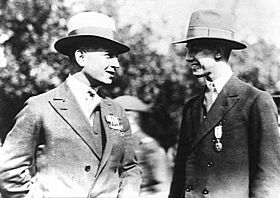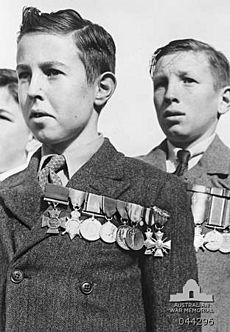Issy Smith facts for kids
Quick facts for kids
Issy Smith
|
|
|---|---|

Issy Smith (left) attending an Anzac Day parade on 25 April 1927. On the right is Stanley Gibbs, recipient of the Albert Medal.
|
|
| Born | c. 18 September 1890 Alexandria, Egypt |
| Died | 11 September 1940 (aged 49) Melbourne, Australia |
| Allegiance | United Kingdom |
| Service/ |
British Army |
| Years of service | 1904–1912 1914–1919 |
| Rank | Sergeant |
| Unit | 1st Battalion, The Manchester Regiment |
| Battles/wars | First World War |
| Awards | Victoria Cross Croix de Guerre (France) Cross of St. George (Russia) |
Issy Smith (born around 18 September 1890 – died 11 September 1940) was a brave British-Australian soldier. He received the Victoria Cross (VC), which is the highest award for courage in the Commonwealth and the United Kingdom. He also earned the French Croix de Guerre and the Russian Cross of St. George. These awards were given by their governments for his amazing bravery.
Issy Smith was born Ishroulch Shmeilowitz in Egypt. As a child, he traveled to Britain by hiding on a ship. He joined the British Army in 1904. Later, he moved to Australia. But when World War I started in 1914, he was called back to serve. As a corporal in the 1st Battalion, The Manchester Regiment, Smith fought in the Second Battle of Ypres. On 26 April 1915, he bravely rescued wounded soldiers. He did this while under heavy enemy fire, showing great courage. Because of his actions, he was recommended for the Victoria Cross, which he received in August 1915. After the war, Smith returned to Australia with his family. He became an important person in Melbourne's Jewish community.
Early Life and Army Start
Issy Smith was born in Alexandria, Egypt. His parents, Moses and Eva Shmeilowitz, were French citizens of Russian Jewish background. His father worked for the French Consulate-General. When he was 11, Smith secretly boarded a ship to London.
In London, Smith went to school and worked as a delivery boy. He lived in the East End, a poor area where many Jewish immigrants lived. Millions of Jews from Eastern Europe had moved to places like Britain to escape hardship.
In 1904, he joined the British Army. He became a private in the Manchester Regiment. He used the name Issy Smith, which a recruiting sergeant suggested. Smith completed his training and served in South Africa and India. He was a good boxer and won the British Army's middleweight championship. He also played football. While in India, he took part in the Delhi Durbar parade and received the Delhi Durbar Medal.
Smith left the army in 1912. After working briefly in London, he moved to Australia. He lived in Ascot Vale, a suburb of Melbourne. There, he worked for the city's gas company. But in August 1914, when World War I began, the British Army called him back as a reservist.
Bravery in World War I
Smith served with the 1st Manchester Regiment. They fought in tough battles like Givenchy and Neuve Chapelle. By April 1915, his regiment had many injured soldiers. The Second Battle of Ypres began on 22 April 1915. During this battle, the Germans used poison gas for the first time on the Western Front. Smith himself was temporarily hurt by the gas.
During an Allied counter-attack, Smith showed incredible bravery. He went by himself towards the German lines to help a badly wounded soldier. He carried the soldier about 250 yards (228 meters) to safety. All this time, he was under heavy German machine-gun and rifle fire. The award citation said he brought in "many more wounded men" throughout the day. He did this under very dangerous conditions, not caring about his own safety. Sergeant Rooke, one of the men Smith rescued, told a newspaper, "He behaved with wonderful coolness... no man deserved a Victoria Cross more thoroughly than he did."
| No. 168 Acting Corporal Issy Smith, 1st Battalion, The Manchester Regiment. |
| For most conspicuous bravery on 26th April, 1915, near Ypres, when he left his Company on his own initiative and went well forward towards the enemy's position to assist a severely wounded man, whom he carried a distance of 250 yards into safety, whilst exposed the whole time to heavy machine-gun and rifle fire.
Subsequently Corporal Smith displayed great gallantry, when the casualties were very heavy, in voluntarily assisting to bring in many more wounded men throughout the day, and attending to them with the greatest devotion to duty regardless of personal risk. |
| The London Gazette, 20 August 1915 |
Smith was sent to a hospital in Dublin, Ireland, to recover from the gas attack. Later, King George V presented him with his Victoria Cross at Buckingham Palace. Newspapers like The Jewish Chronicle praised him. The British government used his story to encourage more people to join the army.
He visited Jewish communities in the United Kingdom, drawing large crowds. In September 1915, he went back to his old school in the East End. His former schoolmates gave him a gold watch and chain to honor his Victoria Cross.
Smith returned to active duty as a sergeant. He served in Mesopotamia and Palestine. He continued fighting until the war ended with the Ottoman Empire on 30 October and Germany on 11 November. He had been wounded five times during the war.
After the war, Smith returned to London. As a war hero, he was often invited to special events. In June 1920, he attended a garden party at Buckingham Palace. The King hosted this party for all living Victoria Cross recipients. In October 1921, he helped unveil the Hackney War Memorial. In 1922, he visited Ypres in Belgium and laid a wreath at the Cloth Hall.
Life After the War
Even with his fame, Smith faced money problems. His health also started to decline. After the war, he worked in different jobs, including as an actor. In 1925, he moved to Australia with his wife, Elsie. They had two children, Olive and Maurice.
The family settled in Moonee Ponds, Melbourne. There, he joined the local branch of the Returned and Services League of Australia (RSL). In 1928, he became a manager for British International Pictures in Melbourne. He then worked for Dunlop Rubber Company. His last job was with the Civil Aviation Board at Essendon Airport. In 1930, he was appointed a Justice of the Peace. He also tried to become a politician in the 1931 general election, but he was not successful.
Death
Issy Smith died on 11 September 1940 from a heart attack. He was buried with full military honors in the Jewish section of Fawkner Cemetery. In 1990, his family sold his Victoria Cross. It was later sold at an auction as part of a collection of his medals for about £30,000 (US$60,000).
In 2013, it was announced that commemorative paving stones would be laid for British-born World War I Victoria Cross holders. This plan was extended to include Smith, even though he was born in Egypt.


